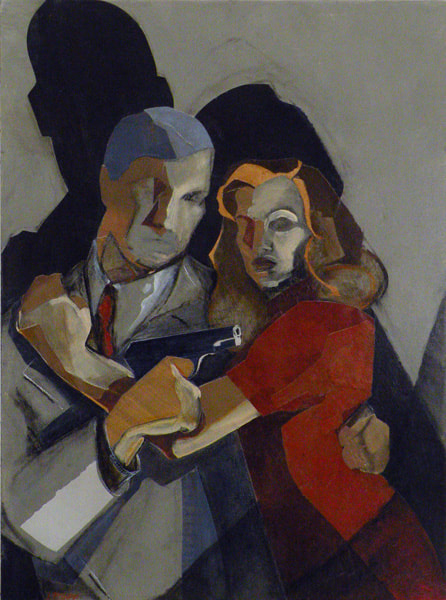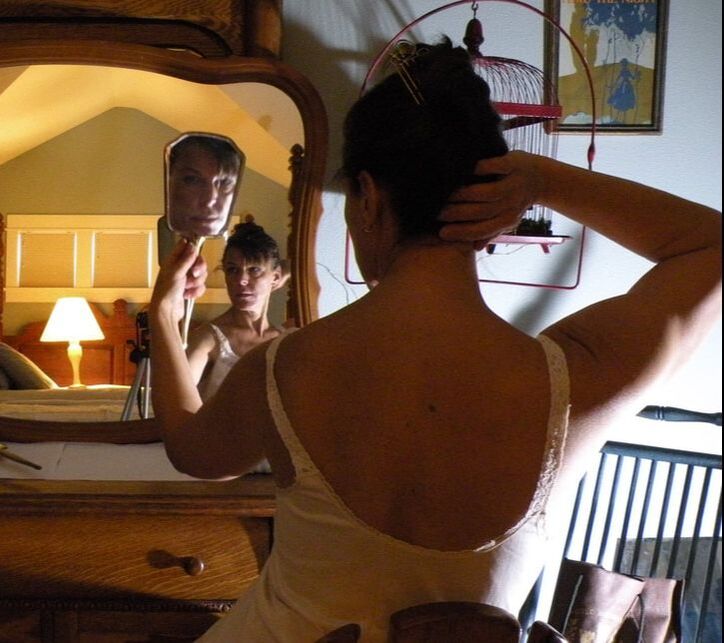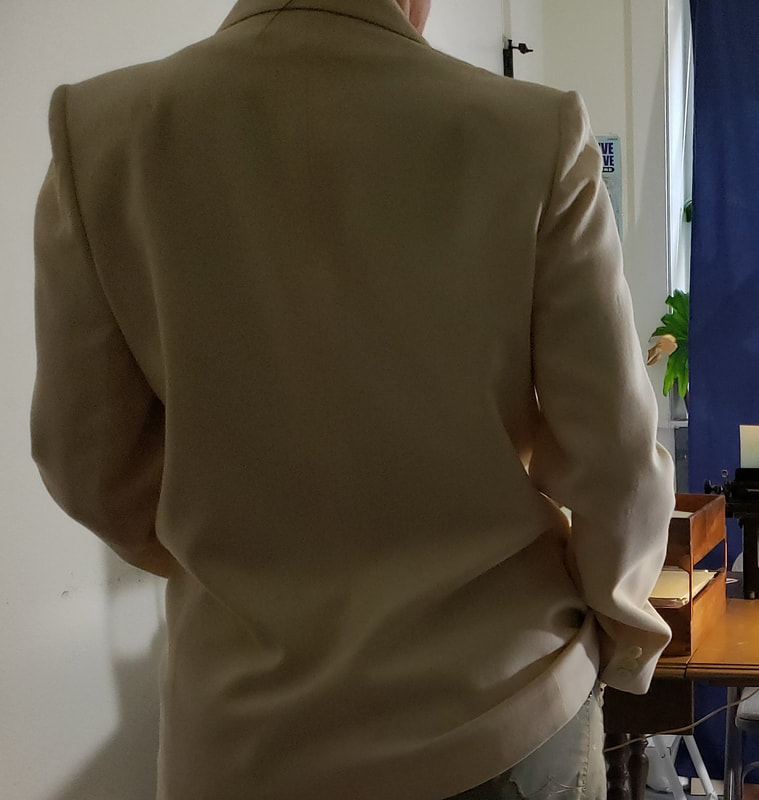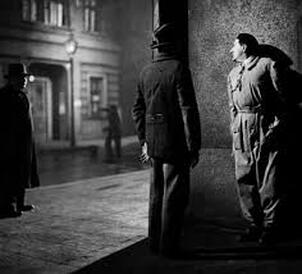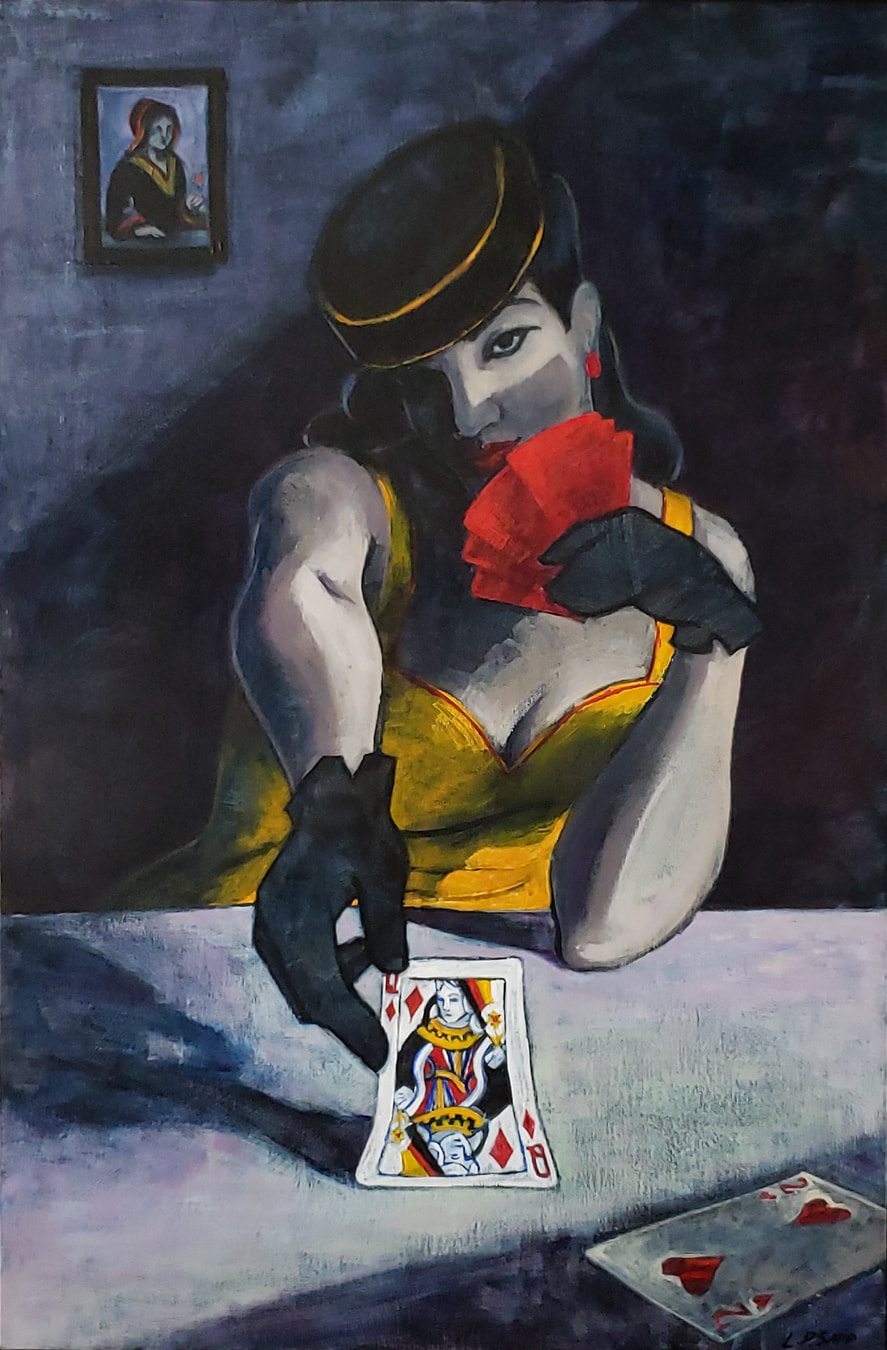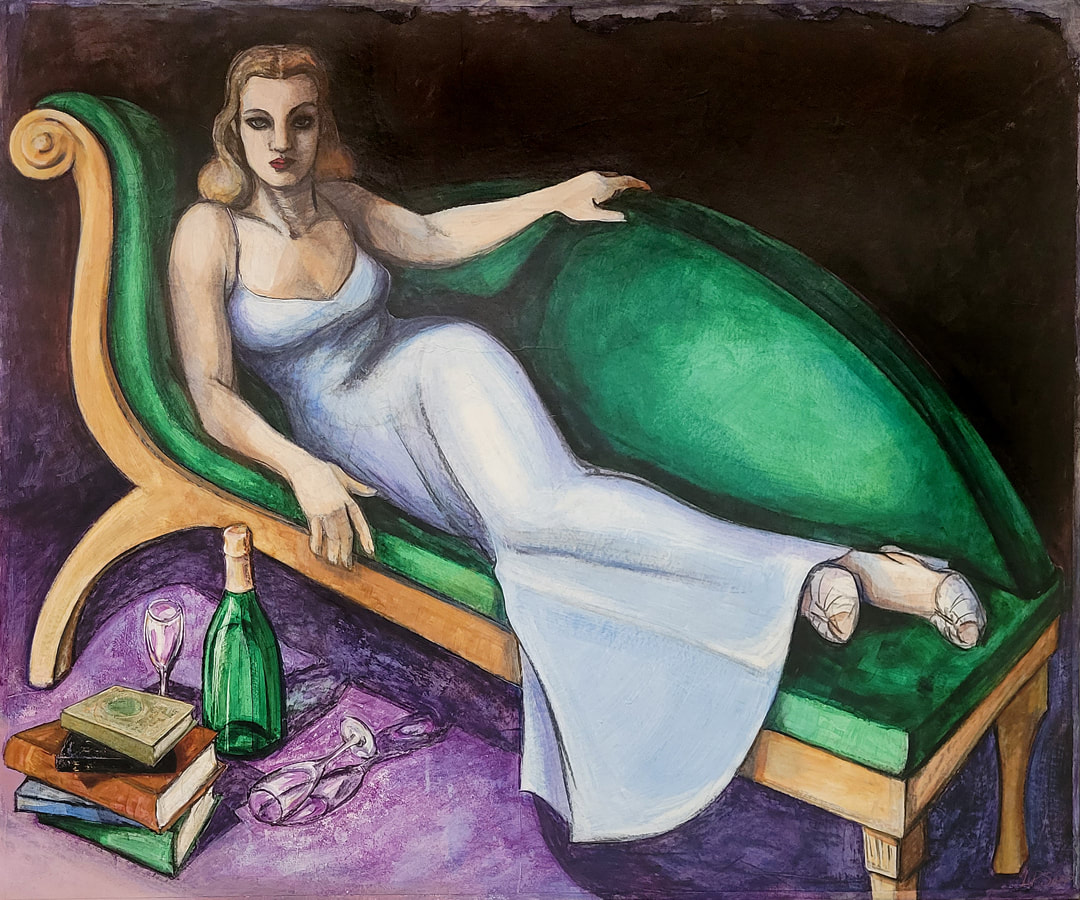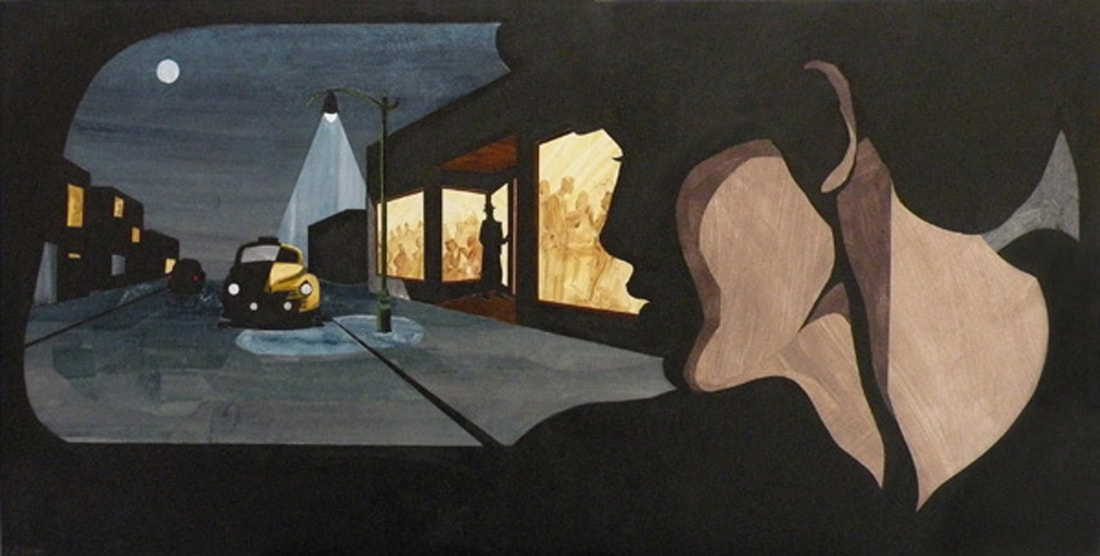Why Noir?
How Film Noir Inspires My Art
|
I am an artist who is inspired by the past. As a narrative painter, I feel compelled to tell a story with my art. For a number of years now, my subject matter has been primarily based on classic film noir imagery. Since I started with this genre, I have engaged with authors, bloggers and social media groups devoted to the subject. I have found enthusiasts out there who seem to know every detail of every film noir; classic American noir, foreign noir, neo-noir- all the noir. This level of detail and focus eludes me. My mind just doesn’t work that way. |
I am an artist. Artists take input and use it as grist to generate unique output.
So, I feel I must ask myself, why noir? Why do I feel myself drawn to this imagery?
So, I feel I must ask myself, why noir? Why do I feel myself drawn to this imagery?
|
I seem compelled to tell a story with my art and create a narrative. For me, the act of telling a story is more important than the trappings of time, place and characters. It is the essence of film noir that I am after, rather than the specific details. During the jazz age, a composer would write a song, then singers and musicians would perform their own version of it. But the structure of the song remained the same. I seek to take the elements of film noir and create my own, unique rendition. |
Film Noir? Qu'est-ce que c'est?
The hey-day of this film genre is roughly the 1940’s and 50’s. But, the term "Film Noir" was coined by French film critics later, in the 1960’s. At the time, they were simply known as “crime pictures” inspired by American hardboiled crime fiction. They were largely “B” movies with a tight budget.
|
Many of them were made by European émigrés escaping the Nazis. They brought with them a grounding in what is called “German Expressionism". The unique and sophisticated aesthetic was not fully appreciated at the time; crime movies ran under the radar and attracted no critical praise. But the superior film making techniques have made them gain popularity over the decades. |
|
The techniques used include deep focus cinematography, extreme camera angles, dramatic lighting shone from raked angles, and chiaroscuro (which is a painterly technique developed during the Renaissance where use of deep variations of light and dark is used to enhance mood and create dramatic effect). |
The term “noir” has since expanded to not just describe a moment in movie history, but to describe a sensibility, that can be infused into any form of expression.
|
To learn all there is to know about noir, check out The Film Noir Foundation, which restores films noir and shows them at their film festivals. It's founder, the Czar of Noir, Eddie Muller, is also a host on TCM's Noir Alley, which shows films noir every Saturday night and Sunday mornings. |
Why Noir? Begin the Béguin
|
Begin the béguin
bé·guin|\ bā-gaⁿ \ noun \ bi-ˈgēn\ Definition of béguin 1. a :infatuation 2. a :a vigorous popular dance of the islands of Saint Lucia and Martinique that somewhat resembles the rumba Etymology: American French béguine, from French béguin: flirtation |
|
How did I start my film noir obsession?
|
I was in a state of transition with my art. Unsatisfied with the work I had been doing at that time, I went back to basics and started experimenting, and taking classes from Mark Andres. I was engaging in an exercise to copy a film still in the style of a painter of my choice. My choice was to do a still from The Bad and the Beautiful, in the style of the German Expressionist, Max Beckmann. I entitled it “Lana Turner Lost in the Land of Beckmann” The drama of the subject, matched with the freedom of Expressionist painting was a revelation. |
I was hooked.
At first, I created my art directly from screenshots of films. They were very altered, but from specific scenes. Gradually, the images kept getting more and more altered, until I started to create my own scenes.
Now, ideas emerge from multiple sources. I may be inspired from a film scene or photograph, or I may want to express something from my own imagination. The people I paint are slivers of my own soul, maybe even archetypes of our collective soul.
The scenes in my artwork are presented without irony and are imbued with an immediacy which invites the viewer to step into the scene as a contemporary moment. If we could walk through the picture frame and become part of the action. If this could be possible, what would you see, and who would be there?
Why Noir?
Studying Film Noir Makes Me a Better Painter
|
As I said, American film noir was born from German Expressionism, an art movement that started at the turn of the 20th century, and encompassed painting, theater, music, literature, and the brand-new medium of film. It sought to express emotion and subjective experience by using symbolism, exaggeration, and distortion. In painting, the elements of design were used to support a narrative. |
|
In cinematography, the techniques used included deep focus, extreme camera angles, dramatic lighting shone from raked angles, and chiaroscuro (which is a painterly technique developed during the Renaissance where use of deep variations of light and dark is used to enhance mood and create dramatic effect). |
|
I consider the masters of film noir my teachers as well as my inspiration. By studying their cinematographic virtuosity, I have become a better narrative painter. Because the noir aesthetic is so specific, I am obliged to narrow my focus and deepen my decisions, which has honed my skills. |
I have become better at marshaling the elements of design, such as value, arrangement, and scale. I believe these skills transcend any specific style and will translate to other subjects as my creative interests evolve.
Why Noir? The Art and Style of the Era
Any artist will tell you, the key to artistic maturity is to discover one's own unique, consistent language. I seek to find a balance of representation and abstraction.
Modern Art, and design in the Modernist period dealt with this specifically.
Modern Art, and design in the Modernist period dealt with this specifically.
While experts say Modernism died with the onslaught of WWII, I think it was a part of the cultural zeitgeist well afterwards, especially in popular culture.
My style is evocative of the painting and graphic arts that were contemporary with the hey-day of film noir. So, not only do I learn from films noir directly, I also love the style of the era, and let this inform the way I choose to depict the subject.
Much like how I engage with the subject of film noir, I like to find the essence of what I am seeing and try to express it with forthright simplicity.
Why Noir? The Femme Fatale
|
First, let us examine the word Femme. Merriam-Webster: Femme: 1. an adult female person 2. a lesbian who is notably or stereotypically feminine in appearance and manner Its French, you know? It comes from the French word for woman. Next, let us examine the word Fatale. Another French word. It means "fatal”. Merriam-Webster:
Fatal: 1. a. causing death b. bringing ruin c. causing failure 2. a. determining one's fate b. of or relating to fate c. resembling fate in proceeding according to a fixed sequence |
Put them both together, and it becomes:
Femme Fatale:
1. a seductive woman who lures men into dangerous or compromising situations
2. a woman who attracts men by an aura of charm and mystery
Femme Fatale:
1. a seductive woman who lures men into dangerous or compromising situations
2. a woman who attracts men by an aura of charm and mystery
The word “nemesis” is often used to refer to an arch enemy or polar opposite, or, as my friend Merriam-Webster sez, “a formidable and usually victorious rival or opponent”.
But if she is so evil, why do we love her so much?
Be good, be patient, look pretty and maybe the prince will come and save you. I was taught that as a girl, it was the foundation of my world view and identity. I had no examples of powerful, non-domestic women in my life. Into this vacuum stepped the only example of feminine power available to me: the Femme Fatale.
|
Classic film noir emerged during a time of immense social upheaval. Women had gone out into the working world during WWII, then were abruptly required to get back to the home and be nice. The Femme Fatale was an expression of this anxiety, an attempt to vilify powerful women and shame them back into the kitchen. Though she is usually regarded as a destructive force of evil, in actuality she is often portrayed with layers of nuance- if you care to look. It is often clear that she is a woman who doesn’t have a lot of choices. |
She is trying to flip a bad situation to her advantage, perhaps turning the tables of power back on the men who use and control her. For me, the Femme Fatale is often infused with a tragic quality: a resourceful gal, just trying to make the best from a bad hand dealt.
In the course of my personal maturity, I am finding my way to a healthier embodiment of power. It has taken most of my adult life to build up some understanding of how to be an entrepreneur, which is essentially what a professional artist is.
I’ve had a lot of catching up to do.
I’ve had a lot of catching up to do.
But all the while, I still rejoice in the cathartic glorification of my dark princess, the lost twin star, our nemesis, the Femme Fatale.
Why Noir? The Antihero and The Homme Fatale
How many times have you said to yourself, "this is a bad idea,"- then went ahead and did it anyway?
This is the essence of the typical male protagonist in film noir. A guy who is presented with a choice, and even though it is a bad idea, he goes forward with his instincts, his craving, his desire, his compulsion, his desperate need, instead of what we know would be the right choice. He must live, or die, by that fateful decision.
We watch the drama unfold, unable to look away.
We watch the drama unfold, unable to look away.
Men have their own particular burden to carry. They are supposed to do, to achieve, attain, and win. But the world does not have a level playing field. Additionally, he knows that when the going gets tough, he's the one who is expected to run into the fray, stare it down and fix it. But what if it is unfixable?
The strive to win against all odds is often what motivates Antihero- or the giving up is what fuels his self-destruction.
The strive to win against all odds is often what motivates Antihero- or the giving up is what fuels his self-destruction.
The Homme Fatale
Not all Fatales are Femme. Any androsexual will tell you so.
|
A fatal attraction to the “bad boy” is the plight of many an otherwise prudent woman. Many are compelled to “fix” or heal a wounded man. The bad boy seems like a shiny, bright apple on the tree of life, just out of reach. Women tell themselves, “If only I could reach him, hold him, heal him. Then he would be mine.” But this is an illusion. Another cathartic mechanism in the fantasy world of film noir.
In the real world, such men are exasperating at best- dangerous at worst. |
|
The simple fact is, in our society, men suffer from emotional isolation and alienation. This is no cakewalk, and should not be in any way romanticized. Yet, the figure of the bad boy, the homme fatale is as romantic as they come. There is a type of strength that we associate with the quiet suffering we associate with masculinity. The lonely man, isolated and aloof has great dramatic and sexual appeal. |
But here we must ask the age-old question; is the catharsis we gain from art worth the messaging it perpetuates?
Why Noir? The Doomed Romance
A long time ago, a wise friend counseled me, saying “Romance is about NOT being fulfilled, it’s about longing.”
The characters in film noir practice a lot of bad behavior. They smoke and drink, lie, cheat, extort and manipulate.
|
I, on the other hand, have developed a preference for a life of minimal drama. Life is too damn short to spend it with worry and strife. Yet, in much the same way someone may like a good war movie, yet has no desire to engage in combat, many of us achieve a certain catharsis by watching the sufferings of the glamorous figures in a film noir. My art is charged with longing, drama, sexual tension, taboos, and covert couplings. Like a private eye, snapping a picture through a window, we espy people in places they are not supposed to be, or with someone they ought not to be with. You could say I vicariously through my own art. |
Why Noir? It's Complicated
When we are engrossed in a mystery novel, the complicated plot tangles we must unravel keep us entranced.
The characters in noir are caught in a web of intrigue and moral ambiguity. Their exploits involve daring and danger, plot twists and betrayals. They usually believe they can manipulate a situation to their advantage over another.
The dream I weave in my paintings is a version of myself who is, in a word: clever.
|
Very unlike who I really am. In my artwork, the space can be complicated and sometimes difficult to navigate. The claustrophobic, multi-layered space illustrate the sometimes-turgid complexity of our minds and relationships. The identity of figures is often obscured, sometimes visually competing with shadows that seem more alive than they are. |
Like getting into a good novel or movie, my paintings invite you to take time and decipher what is being presented.
Why Noir? The Unusual Suspects
Why is Shakespeare still so popular after all this time? It's because his stories and characters are timeless. There have been countless versions of his plays where the settings and characters’ identities are changed to bring new interpretations to the story presented.
There are a profusion of examples of crime novels that star characters of many kinds, from the famous private eye Easy Rollins, to tough gay guy/investigator Dave Brandstetter.
The themes are universal and can be ascribed to any individual. So, I can change the outer identities of my characters, and it can still be noir.
|
The scenes in my artwork are presented without irony and are imbued with an immediacy which invites the viewer to experience the scene as a contemporary moment. They don’t coyly refer to themselves as being "film noir" or use signifiers to make them seem like cultural artifacts. There is no breaking down of the fourth wall. It is as if we could walk through the picture frame and become part of the action. If this could be possible, what would we see, and who would be there? |
|
It is easy for me to depict white, cis-gender women. It’s more of a stretch to depict scenes with people outside my personal lived experience. But the figures in my work and in my imagination sometimes take on a life of their own, and want to be expressed as they are: male, non-white, queer... |
To not follow these impulses would, in effect, be negating their existence.
Whether I handle this successfully is a question I continually ask myself.
The adaptability of film noir characters allows me to enlarge the limits of my understanding and expression.
Why Noir? It's Fate, Baby.
Being an artist may look like fun, but it is tough.
Putting yourself out there for others to see is perennially disquieting. In order to make it all worth it, the subject and method has to be captivating.
Putting yourself out there for others to see is perennially disquieting. In order to make it all worth it, the subject and method has to be captivating.
|
I am compelled to tell a story with my art. No matter if it is based on Shakespeare, mythology, or film noir, I am driven to explore and share the landscape of my imagination. Similar to the myths and stories of old, the characters are driven by forces larger than themselves and are so very, very human. Often being brought down by their own drives and weaknesses, they are driven by a futile effort to cheat Fate. The themes are undying elements of what it is to be human. |
|
By utilizing the elastic armature of the elements of film noir, I create art that is charged with longing, adventure, romance, and intrigue. I am able to expand and deepen my skills as a person and an artist, all the while having the time of my life. For now, I am entirely caught up in the dark labyrinth of film noir. But who knows what future stories my art will tell? |
